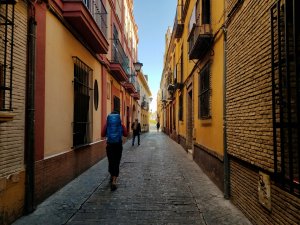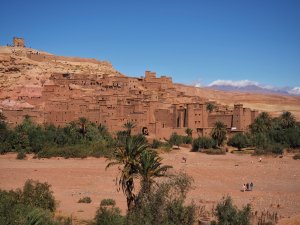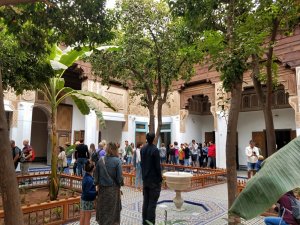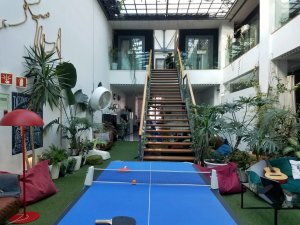Granada vs. Seville – it’s not a simple comparison. This isn’t a debate of choosing Granada or Seville in a soccer game. Which Andalusian city should you visit on your trip to Spain?

If possible and time permits, Granada and Seville (Sevilla) are both excellent places to travel in Spain. When time is not on your side, choosing a travel destination can be more complicated.
These two Spanish cities are both popular with tourists for a reason. Before you choose – if you have to choose – compare Granada vs. Seville in this analysis. Decide which one is the better place to travel for you.
Seville vs. Granada – The Main Attractions
Granada and Seville both have fantastic attractions that draw tourists. What about the top attractions? Does Granada or Seville have the better landmark travel highlight?
Granada:
The Alhambra complex is the major tourist draw in Granada. The grounds consist of palaces, a ruined fortress, extravagant gardens and even an art museum. All of this comes with great views over the city of Granada.

Alhambra is an enormous source of tourism. Millions of tourists visit each year, and it is a place that I could easily spend half a day wandering around (again).
Seville:
The famous Cathedral of Seville is the most prominent and popular tourist attraction in Seville. This massive church, one of the largest in the world, draws thousands of tourists and religious pilgrims on a daily basis. Seville Cathedral has tons of history, jaw-dropping interior decor and even the tomb of Christopher Columbus.

Seville Cathedral also has the best view in the city. The bell tower, a former minaret, provides marvelous views of the city center in Sevilla.
Granada vs. Seville – which has the better major tourist attraction? Both of these sites are stunning, picturesque and full of history. The Alhambra is more difficult to visit and more expensive, but it is the clear winner here.
Seville Cathedral is cool, but there are a lot of massive churches in Europe. That’s not a bad thing; Seville Cathedral is different from other large European churches, but the Alhambra is definitely the more unique attraction.
Other Tourist Attractions
Aside from the major attractions in each city, which place is better for a variety of tourist attractions?
There are plenty of interesting things to do in Granada. Granada has big beautiful churches, too, and the hilly city also has several fantastic view points. But, truthfully, there aren’t that many significant, landmark tourist attractions in Granada aside from Alhambra. It is a city to visit for other reasons, which we’ll cover below.
On the other hand, Seville has tons of noteworthy tourist attractions. Aside from the imposing cathedral, Seville has the beautiful Plaza de Espana, Roman ruins scattered in and around the area, a famous royal palace (alcazar), modern architectural curiosities and a host of several impressive museums.

As far as significant, “noteworthy” tourist attractions, Seville is the clear winner versus Granada. Seville’s larger size and greater historical importance are the reason there are so many notable attractions in the city.
Seville vs. Granada – Where is the Better Food?
The Granada vs. Seville battle for best food is a terribly difficult and complicated contest to judge. Picking a clear winner will surely anger someone from one of these places. Both of these cities have phenomenal cuisine that represents everything travelers love about Andalusia.
First off, I want to make it clear that neither Seville nor Granada has explicitly better food. In fact, I genuinely want to return to both of these cities for no other reason than to eat. Of course, I’ll squeeze in other tourist activities, but food is my primary motivation.
However, despite each city having delicious cuisine, that doesn’t mean they’re equal. Both cities might be in Andalusia, and both are known for a culture of tapas, but there are significant differences that can tip the scales in one direction for hungry travelers.
Granada is known for tapas. Eating tapas in Granada is not just about filling your belly. It is an experience. There are few instances where tourists dine with locals in an authentic environment like the tapas scene in Granada.

It doesn’t matter whether a restaurant in Granada is popular with tourists. That’s not enough to scare locals away. Locals dominate the clientele at good tapas hotspots, and tourists are welcome to join.
The best part of the lively tapas culture in Granada is that it’s free. Patrons pay for a drink and, moments later, a plate of food comes out. In the less-touristic places, the small plates are bigger and better.
Eating in Seville is every bit as enjoyable as in Granada. Tapas in Seville are a big deal, too, though slightly different than Granada. For starters, they aren’t free, but tapas in Seville are cheap and usually larger portions.

As a larger city, there are more options for eating in Seville. And the city has several notable local specialties. However, with its larger size and greater number of tourists, there are also a lot of tourist restaurants crowding the plate in Seville.
Granada vs. Seville in terms of food is a draw. There may be no clear winner, but there is, more importantly, no loser. Each city has delicious eats and a lively tapas scene.
Personally, I want to go back and eat in Granada more than Seville. Eating in Granada is one of my all-time favorite travel experiences. That being said, I would probably head to Seville shortly after a few days of eating in Granada.
Granada or Seville – Which City is More Touristy?
The unfortunate truth is that both Seville and Granada are very touristic cities. Spain, in general, is a popular destination for tourists with Andalusia being one of the more popular regions within the country.
The deep history of these cities means that there are a lot of attractions. A lot of tourist attractions means, obviously, a lot of tourists.

The center of Seville may be incredibly lovely, but it is extremely touristic. Between the charm and beauty are tour groups, souvenir shops and thousands upon thousands of tourists sprawling out from the center.
Tourism in Granada is more concentrated. The Alhambra’s position perched atop a hill surrounded by a park means that other tourist activities are down below in the city itself. Some of these streets are flooded with tourists, but the “tourist sprawl” in Granada is significantly more contained.

The larger size of Seville makes it easy to lose crowds and escape touristy scenes. Large chunks of the city are especially touristy, though. Granada may have some serious tourist business, but the city is less touristy than Seville.
Keep in mind, though, that comparing Granada versus Seville in regard to which city is more touristic is a bleary comparison. It is easy enough to escape tourist crowds in each city, but each also has more than its fair share of visitors.
Which City is Better for Wandering
Words like “beautiful” and “charming” and “picturesque” are more commonly associated with Seville than Granada. Part of this is due to the fact that the buildings are a little more colorful. Another reason is simply the greater volume of tourists visiting Seville.
Seville is not inherently more attractive than Granada. The two cities are just different. Though they are both in Andalusia, the differences of these two cities are significant. Granada is hilly and nestled next to a mountain range, whereas Seville is mostly flat. Both of these cities are pretty and places where it’s difficult for tourists to put the camera down.
So which city is better for a casual stroll of getting lost and wandering around?

Seville is larger, so it has that going for it. It is also one of those cities where you’ll turn a corner and, seemingly out of nowhere, there is a postcard scene or striking piece of architecture. Seville’s popularity also means more crowds.
Granada is hilly, meaning that there are a lot of unique views. The hills also deter lazy travelers. Aside from the most popular viewpoints, most are not crowded. The central, popular area of Granada is beautiful but busy. The farther you wander from Alhambra, the less likely it is that you’ll see many other tourists.

Granada is an ideal city for aimless wandering, but Seville has the edge. Ultimately, it comes down to size. Seville is larger, and most tourists congregate in and around the center of the city.
Wandering around Seville is a treat. Whether it’s on the tiny side streets near the center or across the river in Triana, the labyrinthine nature of the city makes it the perfect place to get lost and lose the crowds.
Travel Costs – Is Granada or Seville Cheaper?
Depending on the season, Spain can be a fairly cheap travel destination. The weather dictates a lot of the costs. Rainy, colder times of year stifle demand for the most part. The exception is something like holidays or festivals. These can cause demand (and prices) to skyrocket regardless of weather.
Granada vs. Seville in terms of travel costs is pretty clear: Granada is cheaper. The big city effect, the same factor that influences popularity and food, also causes Sevilla to be slightly more expensive.
Compared to Granada, costs in Seville are not significantly higher. Food, which can be a hefty part of my budget, is slightly more expensive. Beer is clearly more expensive, though still pretty cheap.
All of the popular tourist attractions in Seville also add up. The Alhambra is more expensive than any of these, but there are more places of interest with admission fees in Seville.
Hotels can be as expensive as you want them to be. There are more pricey hotels in Seville, but there are plenty of affordable options, too. As far as hostels go, prices are similar, but Seville has more options.
Overall, Granada is cheaper. But prices in Sevilla are not so high that you’ll want to avoid the city or shorten your stay.
Transportation – Better in Granada or Seville?
Cities in Spain typically have good public transportation. Not all cities are the same, and if ease of getting around is a concern for your visit, consider the quality of public transportation in Granada versus Seville:
Intra-city Transportation
Both Sevilla and Granada are walkable cities. Most of the top tourist attractions are centrally located and easy to reach on foot.
Granada has a greater change in elevation than Sevilla. Its location at the foothills of the Sierra Nevada mountains means portions of the city contain fairly steep hills. With a lot of narrow streets, public transport is limited reaching some of these areas.
The bus system in Granada is adequate enough for tourists, but there isn’t really much need to use it. Granada has a light rail network that is severely limited and only useful if you’re arriving at the bus station.
Seville is pretty much flat. Walking in the city is the simplest way to get around. The exception would be in the high heat of Summer, during which time Sevilla is notoriously hot.

Otherwise, Seville is one of the most bike-friendly cities in Spain, and it has the best public transportation network in Andalusia. This includes trams in the city center, a metro system and an extensive bus network.
Inter-city Transportation
The biggest difference in transportation for Granada vs. Seville is the regional and national transportation network. Seville is the clear leader in this category.
Granada has a train station that is all but useless to tourists. Trains from Granada do not connect to any other major cities. Forget what the internet says, there is not a direct train from Granada to Seville, Cordoba, Malaga or Madrid. Not even the slower “media distance” train.

To reach Seville by train from Granada, you have to first take an hour-long bus to Antequera. In my case, I had to take a bus from Granada to Antequera, a second bus to Osuna and finally a train to Seville.
It’s not difficult to get around Spain from Granada, but the schedule is unreliable and inconsistent. It is much easier (and faster) to travel by bus, such as ALSA, from Granada to reach Seville or other cities in Andalusia.
Seville has similar regional bus connections as Granada, so there is minimal difference in that transportation option. Seville’s Santa Justa train station can transport travelers across Spain. It has several high-speed, long-distance routes. These tend to be expensive but save a lot of travel time.
Should you want to rent a car and drive yourself, a road trip in Andalusia is also an excellent way to see the region. The freedom to get around and go for a hike or stop at any of the alluring villages or beaches is tempting to say to the least.
Air Transportation
Granada and Seville both have international airports. The destinations served and capacity of the airports are another big difference between the two cities.
Granada has an airport about 20 minutes west of the city. The airport is essentially good for flying to Madrid and a few other cities in Western Europe.
Seville Airport (Aeropuerto de Sevilla) has a much larger operation than Granada. Aeropuerto de Sevilla is one of Spain’s busiest airports and has regular flights to several Spanish cities and dozens of cities in Europe.
In regards to transportation, Seville is the clear winner vs. Granada. The city is flat, bike-friendly and has excellent ground and air connections to Spain and Western Europe. Granada isn’t remote by any stretch, but it is a little more tedious getting to/from the smaller city.
Granada or Seville, Who Wins?
The comparison of Granada vs. Seville is a difficult competition to judge. Both cities have positives. Seville is easier to reach and has more specifically notable attractions. Granada is smaller, has better tapas and has a beautiful backdrop of mountains.
On the surface, Seville seems like it would be the clear winner. It has everything a tourist looks for in a travel destination – food, history, culture, pretty sights – and that’s why it is so popular.

Granada has the intangibles, though. In addition to being an aesthetically pleasing city, notable attractions and having great food, there’s something about the city that stands out. Maybe it’s the feeling that local life not only exists in the tourist bubble – it thrives. Tourism and local life coexisting in this manner is a rarity in the 21st century.
Neither Seville or Granada is the better city to visit. They’re both great, but I do have a preference.
Granada is one of my favorite cities in the world. My visit was supposed to be two or three days and I stayed for over a week. I almost rented an apartment to stay for a month, but prior commitments, life and all that got in the way.

I also loved Seville. Despite its more-touristic nature, Sevilla is a beautiful, lively city. It has phenomenal food, too, but there’s just something extra special about Granada.


































You must be logged in to post a comment.